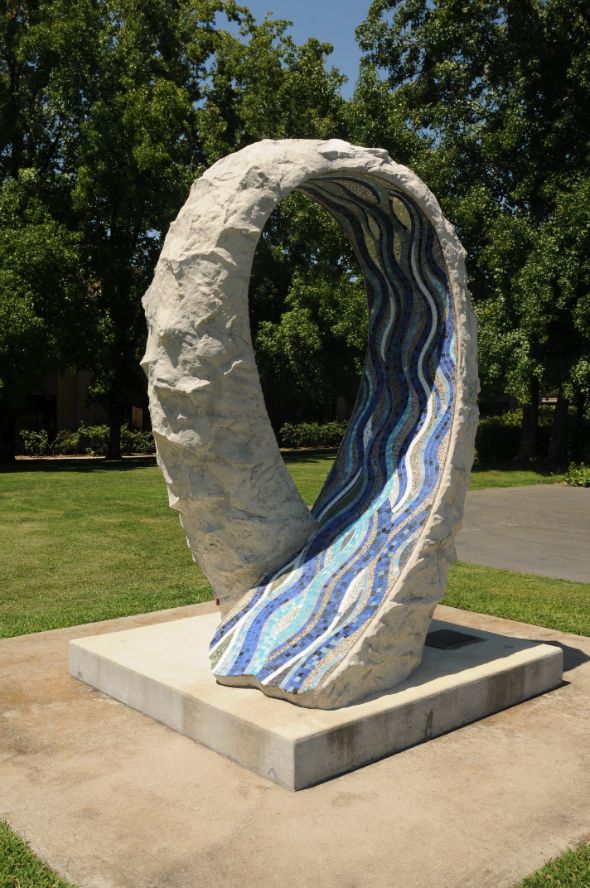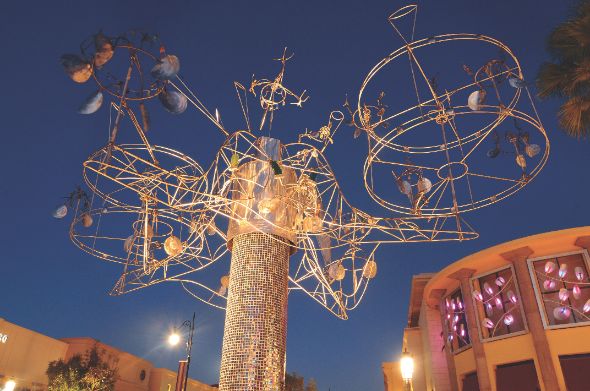Works of Public Art
Aug 31, 2012 04:46AM ● By Style
Photos by Dante Fontana, © Style Media Group.
Public art is a delicate balance of artistic expression – harmonizing the need of the community with the voice of the artist – in hopes the end result will express an idea of who we are.
You. Us. But it needs you to notice it. Next time you’re wandering around town, take the time to observe or even spend some time with the public art. “We don’t know where it is!” you might cry. “Don’t cry,” we say. “Come with us, and we’ll show you.”
Every piece of public art has a story. Some of the artists and contributors behind some of our most renowned pieces of public art granted us the pleasure of sharing the stories behind their creations. Welcome to “Public Art Appreciation 101.” But the greatest secret to appreciating public art is you really don’t need the “why” for it to come alive. Like any masterpiece, all it really needs is you. (We just blew your mind, didn’t we?)
HORSES DE PALLADIO
Palladio at Broadstone, Folsom
Harmony between art and retail space is the essence of Palladio Folsom. “Elliott [Homes] embraced the inclusion of art in the Palladio project in a manner beyond our expectations! I have already seen lots of visitors, young and old, interacting with the art, posing for photos in front of the artwork or just having fun viewing it!” says Sandy Hilton, community and cultural services manager with Folsom Parks and Recreation Department.
One of the minds behind that fun is local sculptor J. Randall Smith, responsible for the Herons de Palladio at the Piazza De Fiori fountains and the four Horses De Palladio at Via Sole and Via Serena. Inspired by ancient Asian and European art, with a touch of Tim Burton-esque whimsy, the enameled and weathered metal finishes of the Horses De Palladio belie a lightweight fiberglass construction. The cracks, patinas and enamels are a nod to Smith’s trademarked Kraku™ technique, which he originated on smaller pieces – where ceramic sculpture shards were individually fired using the Japanese method of Raku and reconstructed – preserving the cracks, hence the Kraku™ technique.
Says Smith, “That is what [Elliott Homes] saw when they came into the gallery, and they said they would like me to do this broken horse look. For such large pieces, obviously, I’m not going to make them out of clay and fire them. So it was just dividing up the sections, adding the medium to it, putting the copper finish on it, and adding a patina and sculpting in the cracks to make it look like it was broken.”
Vincent Van Gogh once said, “I feel that there is nothing more truly artistic than to love people.” The artistic core of Smith’s Palladio work is his love for his grandson Aiden. Says Smith, “I was working on the rump of the horse in the studio, and it was his fourth birthday so I had him come up and press his hand in.” Smith pressed his hand in as well, and you can see the handprints clearly on the sculpture today. “This way when he’s in his 20s, my four-year-old grandchild will be able to say ‘My pappa did that for me,’” Smith says. (The Herons De Palladio is also linked to Aiden – they are all signed “For the love of Aiden.”) Grandfather and grandson, forever linked in both life and in art.
For more information about J. Randall Smith, visit jrandallsmithart.com.
FOLSOM BOUND
Historic Folsom Light Rail Station
Public art is a collaboration of sorts – with the city, with the community and with the public space itself. When it came time to create Folsom Bound at the Historic Folsom Light Rail Station, Philip Sciortino – longtime sculptor and contributor to public art all over the Folsom and Sacramento region – embraced the collaboration process. Sciortino recalls, “There was much afterthought; I really changed it a lot. I didn’t mind changing it...I was glad there was civic interest. There’s a lot of civic interest in Folsom. People of Folsom really get involved with their community.”
Sciortino’s Folsom Bound was a joint project of Regional Transit, the Folsom Arts and Cultural Commission, and the Sacramento Metro Arts Commission. “The selection committee wanted the artwork in the Historic District station to reflect the history of Folsom. Philip demonstrated that he had a great understanding of what the committee was looking for, and his traditional style of work fit with what they were seeking,” says Sandy Hilton, community and cultural services manager with Folsom Parks and Recreation Department.
Expertly cast in bronze, using an intricate, multi-step process known as “lost wax” casting, Sciortino’s Folsom Bound shines historical light on railway pioneer Theodore Judah, the great mind behind the Sacramento Valley Railroad and the first man with the audacity to dream of such a thing as the Transcontinental Railroad. A Chinese worker, Negro miner and a Native American fisherman are included in the tableau, but it may be Sciortino’s choice to include Judah’s wife, Anna, that is the most insightful. Not only a spouse, Anna was Judah’s friend and confidante throughout his many trials and tribulations. “There is no question how important my wife is to me. She’s very much involved and supports everything I’m interested in. [Anna Judah] was quite involved with almost everything that [Judah] did,” Sciortino says. Thanks to Sciortino, it may be one of the few rare instances where Mrs. Judah has received such a public “moment in the sun.”
Our greatest achievements are born of dedication and collaboration – with public art, and so, too, with railroads and marriages!
For more information about Philip Sciortino, visit philipsciortino.net.
ROCK ‘N’ RIVER
48 Natoma, Folsom
As a young artist in London, Colin Lambert struck up a friendship with famed landscape designer Russell Page, who became something of a mentor to Lambert. The lessons Lambert learned from Page – having worked together on numerous public art projects – can be seen today, including Lambert and Peter Adams’ collaboration at 48 Natoma, Rock ‘N’ River. “[Russell told me] ‘When you go to the site, you must go there with no momentum, and no personal agenda. Go there quietly, and stay there in silence. If you stay long enough the site will converse with you.’ What you see in front of you, it tells you what it wants. You don’t have to come in and lay some idea on it; the site can be very articulate. This has worked really well for me in my career. It’s the approach that Peter and I took with [Rock ‘N’ River]. That image has nothing to do with us. It has to do with the place, the people who want it, the people in the public who will experience it,” Lambert says.
Constructed in 2007, Rock ‘N’ River was funded by McCarthy Cook & Co. and Take pART in the ARTs donations. Sandy Hilton, community and cultural services manager with Folsom Parks and Recreation Department, recalls, “Selection committee members liked the rhythmic life and scale of the design.”
Rock ‘N’ River harmoniously interacts with the 48 Natoma space in both size and scope, incorporating the two iconic elements of Folsom: granite and water. The cast stone nods to the historic granite quarries, and the bright mosaic and inlaid aluminum recall the rivers and lakes that are still at the heart of Folsom. The polished aluminum inlays were an experiment, an attempt to capture the lines of reflected sunlight off the water. Says Lambert, “It was an experiment. Most artists are always at the edge of their understanding. When people start recreating what they’ve done before, the very essence of artistic life is diminished.”
Feedback is always nice, but for Lambert, the finished work in its environment has the final word. “I can look at the site and know that it worked.” We feel the same way!
For more information about Colin Lambert, visit colinlambert.com.
FILM FESTIVAL
Palladio at Broadstone, Folsom
Local sculptor Phill Evans – the brains behind many installations at Palladio Folsom – had a rare opportunity to witness some unique feedback on his whimsical kinetic sculpture Film Festival. Recalls Evans, “At the bottom of the piece I included bronze engravings of the figures of the piece, so people could do a bronze rubbing and take a little of the sculpture home with them...I was [at the Palladio] checking up on the sculptures, and I noticed these young girls in front of Film Festival. There were about six of them, and they were in the poses of the figures that I had on the little engraving. Then they shifted and reposed themselves with a new figure. It was really funny to see this happening, and it caught me by surprise. It was such a satisfying moment for me to see that they got that involved to add their inner spirit into it. It was really fun. I won’t ever forget that.”
Evans’ artistic road began 50 years ago on a southern California beach carving tiki gods, which led to one of his earliest kinetic public works at the 1979 California State Fair, and to the complex and delightful Film Festival now at Palladio Folsom. Constructed of stainless steel and bronze, the sculpture was inspired by the Renaissance idea of theater as a public festival, reflected in the revelry of the 46 individual figures within the sculpture.
Part of Evans’ artistic process is choosing the type of movement suitable for a sculpture’s location. The wind is spoiled at the T-intersection where Film Festival stands, so Evans chose to add additional rotating movement to the piece as he went on – capitalizing on the location, the elevation and the “personality” of the wind.
The beauty of Evans’ sculpture is that the whimsy and the movement belie its complexity. Evans feels strongly about the enjoyment of his art. “If you’re going to do public art, something that light and whimsical is interpreted by many different people, many different ways. That’s what is enjoyable. It’s a form of entertainment.” We could not agree more!
For more information about Phill Evans, visit phillevans.com.
For more information about Folsom’s public art projects and to view other installments, visit folsompresents.com/publicart.html.



